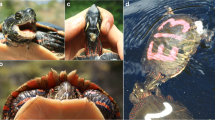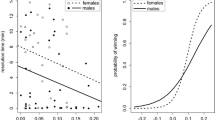Abstract
The spatial distribution of organisms can provide insight into their mating systems, either revealing mating preferences (intersexual selection for ornaments), competition for mates (intrasexual selection for armaments), or both. Teasing apart the relative contributions of these selective forces is a critical step in understanding mating systems, particularly given the potential combinations and complexities that arise when both sexes possess weaponry. We examined the mating system of the maritime earwig Anisolabis maritima, an insect well suited for studies of sexual selection because males differ markedly from females in body size (males are more variable in size, and sometimes substantially larger, than females) and weaponry (males possess asymmetrical, curved forceps, whereas females have straight forceps). We varied sex, body size, and forceps asymmetry among trios of earwigs and examined their spatial distribution under conditions where movement was restricted to promote either intersexual choice or intrasexual competition. Our results indicate strong sexual selection for larger sizes through both competition and choice in both sexes. However, females had no preference for males based on forceps asymmetry. We discuss how the competition and cohabitation patterns provide insight into the mating system, including how the possession of weaponry by both sexes could operate in intrasexual competitive battles as well as serve as a basis for assessing the quality of a potential mate.
Significance statement
Sexually dimorphic traits are often the result of either intersexual selection, where one sex chooses the other based on phenotypic qualities, or intrasexual selection, where members of one sex compete with each other for mating opportunities. Although many mating systems lie squarely on one end of this spectrum, it is often less clear which selection forces shape mating systems when both sexes possess weaponry. We monitored cohabitation patterns to examine the relative roles of mate choice and competition in Anisolabis maritima, an earwig in which males have asymmetrical, curved pincers, whereas females have symmetrical, straight pincers. By restricting the movement of certain individuals within trios, we found that large size but not forceps asymmetry was important in both mate choice and competition. Our results indicate that weaponry and aggression may significantly affect both sexes and contribute to the complexity of the mating system.

Similar content being viewed by others
References
Alvarez F (1995) Functional directional asymmetry in fallow deer (Dama dama) antlers. J Zool 236:563–569
Andersson M (1994) Sexual selection. Princeton University Press, Princeton
Arnqvist G, Rowe L (2005) Sexual conflict. Princeton University Press, Princeton
Bateman PW (2000) The influence of weapon asymmetry on male-male competition success in a sexually dimorphic insect, the African king cricket Libanasidus vittatus (Orthoptera: Anostomatidae). J Insect Behav 13:157–163
Bennett CB (1904) Earwigs (Anisolabia maritima Bon.). Psyche 11:47–53
Berglund A, Bisazza A, Pilastro A (1996) Armaments and ornaments: an evolutionary explanation of traits of dual utility. Biol J Linn Soc 58:385–399
Bonduriansky R, Rowe L (2003) Interactions among mechanisms of sexual selection on male body size and head shape in a sexually dimorphic fly. Evolution 57:2046–2053
Briceño RD, Eberhard WG (1995) The functional morphology of male cerci and associated characters in 13 species of tropical earwigs (Dermaptera Forficulidae, Labiidae, Carcinophoridae, Pygidicranidae). Smithsonian Contribut Zool 555:1–63
Briffa M, Elwood RW (2004) Use of energy reserves in fighting hermit crabs. Proc R Soc Lond B 271:373–379
Callander S, Kahn AT, Maricic T, Jennions MD, Backwell PRY (2013) Weapons or mating signals? Claw shape and mate choice in a fiddler crab. Behav Ecol Sociobiol 67:1163–1167
Campbell P, Akbar Z, Adnan AM, Kunz TH (2006) Resource distribution and social structure in harem-forming Old World fruit bats: variations on a polygynous theme. Anim Behav 72:687–698
Clutton-Brock TH (2009) Sexual selection in females. Anim Behav 77:3–11
Clutton-Brock TH, Harvey PH, Rudder B (1977) Sexual dimorphism, socionomic sex ratio and body weight in primates. Nature 269:797–800
Crespi BJ (1989) Causes of assortative mating in arthropods. Anim Behav 38:98–100
Darwin C (1871) The descent of man, and selection in relation to sex. Murray, London
Davies NB (1991) Mating systems. In: Krebs JR, Davies NB (eds) Behavioural ecology: an evolutionary approach, third edn. Blackwell Scientific Publications, Oxford, pp. 263–294
Emlen DJ (2008) The evolution of animal weapons. Ann Rev Ecol Syst Evol 39:387–413
Emlen ST, Oring LW (1977) Ecology, sexual selection, and the evolution of mating systems. Science 197:215–223
Fisher J (1954) Evolution and bird sociality. In: Huxley J, Hardy AC, Ford EB (eds) Evolution as a process. Allen and Unwin, London, pp. 71–83
Fitzpatrick S, Berglund A, Rosenqvist G (1995) Ornaments or offspring: costs to reproductive success restrict sexual selection processes. Biol J Linn Soc 55:251–260
Forslund P (2000) Male-male competition and large size mating advantage in European earwigs, Forficula auricularia. Anim Behav 59:753–762
Forslund P (2003) An experimental investigation into status-dependent male dimorphism in the European earwig, Forficula auricularia. Anim Behav 65:309–316
Forsyth A, Alcock J (1990) Female mimicry and resource defense polygyny by males of a tropical rove beetle, Leistotrophus versicolor (Coleoptera: Staphylinidae). Behav Ecol Sociobiol 26:325–330
Ghiselin MT (1974) The economy of nature and the evolution of sex. University of California Press, Berkeley
Gwynne DT, Jamieson I (1998) Sexual selection and sexual dimorphism in a harem-polygynous insect, the alpine weta (Hemideina maori, Orthoptera Stenopelmatidae). Eth Ecol Evol 10:393–402
Hack MA (1997) The energetic costs of fighting in the house cricket, Acheta domesticus (L). Anim Behav 8:28–36
Hincks WD (1947) Preliminary notes on Mauritian earwigs (Dermaptera). Ann Mag Nat Hist 11:517–540
Huntingford F, Turner AF (1987) Animal conflict. Chapman and Hall, New York
Iyengar VK, Starks BD (2008) Sexual selection in harems: male competition plays a larger role than female choice in an amphipod. Behav Ecol 19:642–649
Jakobsson S, Brick O, Kullberg C (1995) Escalated fighting behaviour incurs increased predation risk. Anim Behav 49:235–239
Kelly CD (2005) Allometry and sexual selection of male weaponry in wellington tree weta, Hemideina crassidens. Behav Ecol 16:145–152
Kelly CD (2006) Fighting for harems: assessment strategies during male-male contests in the sexually dimorphic Wellington tree weta. Anim Behav 72:727–736
Kelly CD, Godin JGJ (2001) Predation risk reduces male-male sexual competition in the Trinidadian guppy (Poecilia reticulata). Behav Ecol Sociobiol 51:95–100
Kokko H, Jennions MD, Brooks R (2006) Unifying and testing models of sexual selection. Annu Rev Ecol Evol Syst 37:43–66
Kölliker M (2007) Benefits and costs of earwig (Forficula auricularia) family life. Behav Ecol Sociobiol 61:1489–1497
Langston RL (1974) The maritime earwig in California. Pan-Pacific Entomol 50:28–34
Langston RL, Powell JA (1975) The earwigs of California (order Dermaptera). University of California Press, Berkeley
Mariappan P, Balasundaram C, Schmitz B (2000) Decapod crustacean chelipeds: an overview. J Biosci 25:301–313
Maynard Smith J, Parker GA (1976) The logic of asymmetric contests. Anim Behav 24:159–175
Miller KB, Wheeler QD (2005) Asymmetrical male mandibular horns and mating behavior in Agathidium panzer (Coleoptera: Leiodidae). J Nat Hist 39:779–792
Miller JS, Rudolph L, Zink AG (2011) Maternal nest defense reduces egg cannibalism by conspecific females in the maritime earwig Anisolabis maritima. Behav Ecol Soc 65:1873–1879
Moehlman PD, Fowler LE, Roe JH (1998) Feral asses (Equus africanus) of Volcano Alcedo, Galapagos: behavioral ecology, spatial distribution, and social organization. Appl Anim Behav Sci 60:197–210
Moore AJ, Wilson P (1993) The evolution of sexually dimorphic earwig forceps: social interactions among adults of the toothed earwig, Vostox apicedentatus. Behav Ecol 4:40–48
Moore AJ, Gowaty PA, Wallin WG, Moore PJ (2001) Sexual conflict and the evolution of female mate choice and male social dominance. Proc R Soc Lond B 268:517–523
Munoz N, Zink AG (2012) Asymmetric forceps increase fighting success among males of similar size in the maritime earwig. Ethology 18:943–954
Neat FC, Taylor AC, Huntingford FA (1998) Proximate costs of fighting in male cichlid fish: the role of injuries and energy metabolism. Anim Behav 55:875–882
Oliveira RF, Custódio MR (1998) Claw size, waving display and female choice in the European fiddler crab, Uca tangeri. Ethol Ecol Evol 10:241–251
Prohl H, Berke O (2001) Spatial distributions of male and female strawberry poison frogs and their relation to female reproductive resources. Oecologia 129:534–542
Qvarnström A, Forsgren E (1998) Should females prefer dominant males? Trends Ecol Evol 13:498–501
Radesater T, Halldorsdottir H (1993) Two male types of the common earwig—male-male competition and mating success. Ethology 95:89–96
Sauphanor B, Sureau F (1993) Aggregation behaviour and interspecific relationships in Dermaptera. Oecologia 96:360–364
Scudder SH (1876) A synopsis of North American earwigs, with an appendix on the fossil species. Bulletin of the United States Geological Survey 2:249–260
Shuster SM, Wade MJ (2003) Mating systems and strategies. Princeton University Press, Princeton
Simmons LW, Tomkins JL (1996) Sexual selection and the allometry of earwig forceps. Evol Ecol 10:97–104
Sneddon LU, Taylor AC, Huntingford FA (1999) Metabolic consequences of agonistic behaviour: crab fights in declining oxygen tensions. Anim Behav 57:353–363
Tomkins JL, Simmons LW (1996) Dimorphisms and fluctuating asymmetry in the forceps of male earwigs. J Evol Biol 9:753–770
Tomkins JL, Simmons LW (1998) Female choice and manipulations of forceps size and symmetry in the earwig Forficula auricularia L. Anim Behav 56:347–356
van Lieshout E, Elgar M (2009) Armament under direct sexual selection does not exhibit positive allometry in an earwig. Behav Ecol 20:258–264
Vancassel M (1984) Plasticity and adaptive radiation of dermapteran parental behavior: results and perspectives. Adv Study Behav 14:51–80
Walker KA, Fell RD (2001) Courtship roles of male and female European earwigs, Forficula auricularia L. (Dermaptera: Forficulidae), and sexual use of forceps. J Insect Behav 14:1–17
Watson NL, Simmons LW (2010) Reproductive competition promotes the evolution of female weaponry. Proc R Soc Lond B 277:2035–2040
Wong BBM, Candolin U (2005) How is female mate choice affected by male competition? Biol Rev 80:559–571
Wrangham RW, Rubenstein DI (1986) Social evolution in birds and mammals. In: Rubenstein DI, Wrangham RW (eds) Ecological aspects of social evolution. Princeton University Press, Princeton, pp. 452–470
Acknowledgments
We thank A. Summers, B. Swalla, and the staff at Friday Harbor Laboratories for promoting this research and for access to lab facilities and field sites. We also thank E. Iyengar for assistance in collecting earwigs and A.G. Zink, A.L. Bezzerides, and two anonymous reviewers for providing insightful comments on this manuscript. This research was supported by a grant from the National Science Foundation (DBI 1262239).
Author information
Authors and Affiliations
Corresponding author
Additional information
Communicated by J. C. Choe
Rights and permissions
About this article
Cite this article
Kendall-Bar, J.M., Iyengar, V.K. Sexual selection by the seashore: the roles of body size and weaponry in mate choice and competition in the maritime earwig (Anisolabis maritima). Behav Ecol Sociobiol 71, 8 (2017). https://doi.org/10.1007/s00265-016-2233-9
Received:
Revised:
Accepted:
Published:
DOI: https://doi.org/10.1007/s00265-016-2233-9




